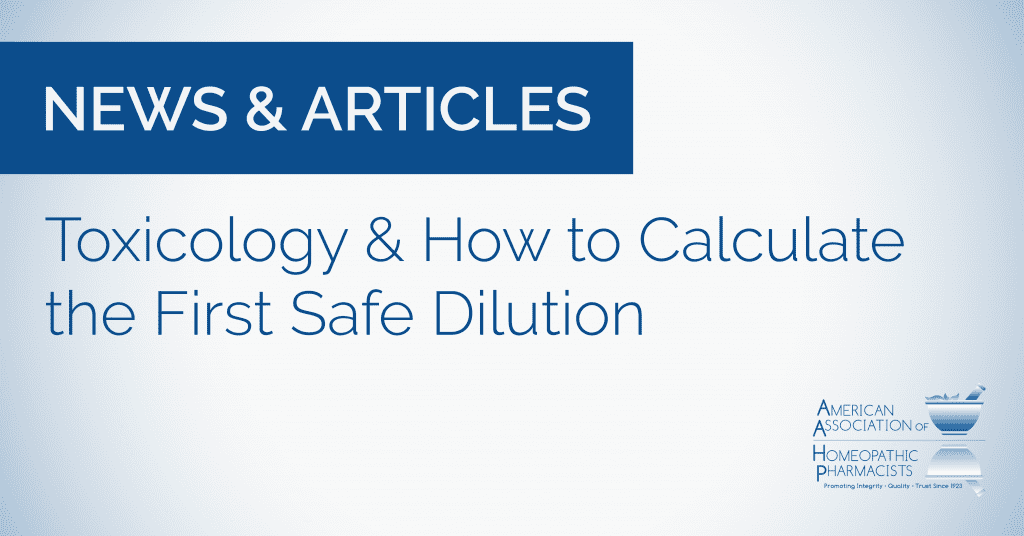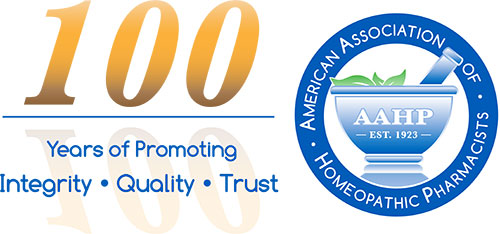Toxicology & How to Calculate the First Safe Dilution

Matthew D. Reed, PhD, DABT, ATS led two workshops at AAHP’s recent Safety Summit, providing an in-depth introduction to the principles of toxicology and risk assessment, an appraisal of the role of toxicological studies in pharmaceutical development, and a review of the methodology for assigning first safe dilution levels.
In assessing risk, Dr. Reed said one must consider:
- Whether a substance causes adverse health effects. (This can be evaluated through an analysis of the substance’s structure and expected activity, or in vitro tests, bioassays or epidemiology. Much of this information may be available in toxicology literature);
- The relationship between the dose and the response, including factors such as susceptibility, and special population considerations;
- Exposure assessment, including the type, level, and duration experienced or anticipated.
From these considerations, the risk can be characterized based on the nature and anticipated incidence of adverse events, how clear and strong the evidence is, and the confidence level of the evaluation.
Dr. Reed pointed out that because human exposure information is too often limited, animal data is the primary basis for most quantitative risk assessments; these must be extrapolated to predict human health risk. He noted one usually chooses the most robust data information with adverse effects at the lowest levels of exposure from studies using the most relevant route of exposure. Of course, there are two general assumptions: animal models will predict safety/toxicity and high doses will maximize model (animal) sensitivity to detect effects. These underlie the information that must be utilized when attempting to determine the most concentrated homeopathic attenuation (the First Safe Dilution or FSD) that is appropriate for OTC sale.
Dr. Reed presented and endorsed the model the HPCUS uses to determine the FSD. For these determinations, the HPCUS Toxicity and Safety Committee considers up to seven categories of information:
- Single Dose (Acute) Toxicity
- Repeat Dose (Chronic) Toxicity
- Genotoxicity, Carcinogenicity, Reproductive and Developmental Toxicity
- Local Tolerance
- Antigenicity
- Immunotoxicity
- Addiction Potential
To determine FSD, HPCUS begins with acute toxicity data from the literature to determine the dilution that would produce a 100-fold margin of safety associated with the accidental ingestion by a 10 kg child of a maximum dose of 30 ml or 16.2 g (250 one-grain size tablets), whichever provides a greater dose, of the substance under consideration. This perspective is based upon a worst-case situation in which a very young child accidentally ingests an entire normal consumer package.
Putting the calculation in words: the FSD is determined by using the maximum amount due to accidental ingestion, multiplied by the presence (percentage) of the toxic substance of concern in the starting material; this arithmetic product is then divided by the minimum quantity known to trigger an adverse event. The result is expressed in scientific notation, and the exponent is rounded up to the nearest integer; to that integer, the quantity “2” is added. This result is the FSD (decimal attenuation); this rounding up and the addition of the quantity “2” ensures that the FSD is at least 100 times less concentrated than the calculated lowest quantity that might cause an adverse event in a 10 kg child who ingested an entire consumer package.
The formula looks like this:
| (maximum accidental X (% content of substance of
ingestion amount) concern in starting material) |
||
| FSD * | = | ________________________________________________ |
| (minimum quantity that triggers an adverse event) |
* when the answer is expressed in scientific notation, the exponent is rounded up to the nearest integer followed by the addition of “2”.
For repeat or chronic exposure, the committee uses the Permissible Daily Exposure (PDE) based upon the No Observable Adverse Event Level (NOAEL). An important toxicological parameter, NOAEL is defined as the highest dose/exposure that does not cause biologically important increases in the frequency or severity of effects between the exposed population and the appropriate control.
While minimal toxic effects may be observed at this level, they are not considered to endanger human health or be precursors of serious events. The NOAEL is not risk free, thus the calculations include factors (that decrease the result of the calculation) based on inherent uncertainties due to extrapolation of animal data to humans, variability between individuals, different study period lengths, potential severe toxicity, and the use of Lowest Observable (Adverse) Event Level or LO(A)EL data when NOAEL information is unobtainable.
Example 1: Safety Margin Arundo Donax
In the Arundo donax example below, a FSD may be calculated by the PDE method because a LOEL is established within the scientific literature.
Risk calculation: Theoretical alkaloid content of Arundo donax is 0.02–0.09%, expressed as gramine. Experimental data reveals Arundo donax Tincture contains not more than 0.09% alkaloids.
Thus 1.25 g Tincture contains no more than 1.125 mg alkaloids.
And 1.25 g Arundo donax 3X contains no more than 11.25 µg alkaloids.
LOEL for Arundo donax is: 6.047 mg/kg/day
PDE = (LOEL x 50kg) / (F1 x F2 x F3 x F4 x F5)
where
F1 = 10 (extrapolation from animal to humans)
F2 = 10 (differences between individual humans)
F3 = 10 (short duration of treatment)
F4 = 1 (no serious toxicity observed)
F5 = 10 (because LOEL was utilized, rather than NOAEL)
PDE = (6.047 x 50) / (10,000) = 0.030235 mg = 30.235 µg
The safety margin for Arundo donax 3X = (PDE) / (alkaloid content of Arundo donax 3x) = 30.235 µg / 11.25 µg = 2.69.
Since the safety margin is more than 1, Arundo donax 3X is safe. (Lit: RTECS 2009)
For substances with potential carcinogenic, teratogenic, genotoxic effects, the committee uses the Threshold of Toxicological Concern (TTC) method. This allows a safety evaluation of substances for which insufficient toxicological data is available. The method also provides a general threshold value below which there is no concern. Dr. Reed provided an introduction to the concepts of the PDE and TTC approaches; however, details go far beyond a quick overview of his two 90-minute workshops.
Example 2: Safety Margin Asarum Europaeum
In the Asarum europaeum example below, it is necessary to calculate both the acute and chronic exposure risks. Because the maximum tolerated dose can be found within the scientific literature, it can be used as a basis for the calculation of a FSD. In this species, beta-asarone is also a potential carcinogen. Therefore the TTC approach is used to evaluate that risk as well. The result is that the 8X attenuation (homologous[1] to 4C) provides a multi-thousand margin of safety in relation to both the acute exposure and chronic toxicity risks.
[1] Homologous: having the same or a similar relation; corresponding, as in relative position or structure; origin: Greek homooios- similar to + -logos proportional (http://dictionary.reference.com/browse/homologous)
A – General acute toxicity procedure
The most toxic component of Asarum europaeum is beta-asarone.
The safety margin is calculated as the ratio of:
- The maximum tolerated daily exposure of beta-asarone from herbal medicinal products
- To the maximum daily dose of beta-asarone provided by a normal use of the homeopathic drug product.
Maximum tolerated daily exposure of beta-asarone:
The maximum tolerated daily intake of beta-asarone in humans is 115 µg/day.
Maximum daily dose of beta-asarone provided by Asarum europaeum 8X (homologous to 4C):
Asarum europaeum tincture contains not more than 0.07% of beta-asarone.
Thus 1 g Asarum europaeum tincture contains not more than 0.7 mg beta-asarone.
And 1 g Asarum europaeum 8X contains not more than 7x10-9% of beta-asarone.
The daily dose of Asarum europaeum 8X is 50-100 drops 2-3 times a day = 100-300 drops per day.
Thus the maximum daily dose of 300 drops (= 7.1 g) provides: 7.1 x 7x10-9% = 0.497x10-9 g /day = 4.97x10-4 µg/day of beta-asarone.
The safety margin for Asarum europaeum 8X = (maximum tolerated daily exposure of beta-asarone) / (maximum daily dose of beta-asarone) = (115 µg/day) / (4.97 x 10-4 µg/day) = 2.3 x 105.
Since the safety margin is more than 1, Asarum europaeum 8X (homologous to 4C) is safe based upon acute exposure.
B - Procedure for mutagenic substances
Beta-asarone is considered as a potential carcinogenic compound for which no long-term study in humans is available. Thus, an additional comparison must be made between the Threshold of Toxicological Concern (TTC) and the expected daily exposure of beta-asarone. In those circumstances when there is no long-term study in humans available, standard toxicological practice is to base the safety margin on a TTC = 1.5 µg/day. Using this basis and the information calculated above the comparison shows:
The safety margin of Asarum europaeum 8X = (TTC) / (Maximum daily dose of beta-asarone contained in 300 drops of Asarum europaeum 8X) = (1.5 µg/day) / (4.97 x 10-4 µg/day) = 3018.
Since the safety margin is more than 1, Asarum europaeum 8X (homologous to 4C) is safe based upon the standard practice of comparison with the Threshold of Toxicological Concern.
The procedure utilized for acute exposure and the procedure utilized for mutagenic substances each provide confirmation that Asarum europeaum 8X is safe.
Dr. Reed provided the following as key toxicology background references:
- Klaassen, C.D., Ed.: Casarett and Doull's Toxicology: The Basic Science of Poisons. 8th Edition, McGraw-Hill, (2013)
- Hayes, A.W., Ed.: Principles and Methods of Toxicology. 6th Edition, CRC Press, (2014)
- ICH Guidelines - Safety (S) and Multidisciplinary M3, M4 and M7. (http://www.ich.org/products/guidelines.html)
- OECD/OPPTS guidelines for the Testing of Chemicals – Human Health Effects (http://www.oecd-ilibrary.org/environment/oecd-guidelines-for-the-testing-of-chemicals-section-4-health-effects_20745788)
- S. EPA Risk Assessment Guidelines - Human Health (https://www.epa.gov/risk/human-health-risk-assessment), and Ecological (https://www.epa.gov/risk/guidelines-ecological-risk-assessment)
- USFDA Guidance for Industry documents (https://www.fda.gov/drugs/guidancecomplianceregulatoryinformation/guidances/ucm065014.htm)
- National Research Council (NRC). 2009. Science and Decisions: Advancing Risk Assessment. National Academy Press, Washington, D.C. https://www.nap.edu/catalog/12209/science-and-decisions-advancing-risk-assessment
- National Academies of Sciences, Engineering, and Medicine. 2017. Using 21st Century Science to Improve Risk-Related Evaluations. Washington, DC: The National Academies Press. https://doi.org/10.17226/24635.
- Torres, J. and Bobst, S. (eds.). Toxicological Risk Assessment for Beginners, Springer, (2015)
- Gilman, A.G., Rall, T.W., Nies, A.S. and Taylor, P., Eds: Goodman and Gilman's The Pharmacological Basis of Therapeutics, 12th Edition (2011)
- Homeopathic Pharmacopoeia of the United States http://www.hpus.com/
- Center for Disease Control and Prevention National Institute for Occupational Safety and Health, Register of Toxic Effects of Chemical Substances (RTECS) https://www.cdc.gov/niosh/rtecs/rtecsaccess.html
- European Commission, Scientific Committee on Food 9 ADD1 final, 2002, ibid. https://ec.europa.eu/food/sites/food/files/safety/docs/sci-com_scf_out111_en.pdf
